
Braces and other modalities of orthodontics may be recommended by an orthodontist for the purpose of improving the orofacial appearance of a patient, enhancing growth and development of the jaws and enabling an aesthetic outcome. Problems such as crowded or crooked teeth, underbites or overbites, and incorrect jaw positions can be corrected with proper orthodontic treatment. Such problems, when left untreated, can result in gum disease, tooth decay, earaches and headaches, chewing or biting problems, and even difficulty speaking.
Patients experiencing orthodontic problems can benefit from orthodontic treatment at practically any age. The best time for orthodontic treatment is determined after a complete examination, and can start in early adolescence as the mouth and jaw bones are still growing at this time. Consequently, the teeth can be easily accessed for straightening.
Even so, it should be understood that braces are not only for children and teenagers. An increasing number of adults are also now choosing orthodontic treatment to correct bite issues and improve the look of their smiles. According to the American Association of Orthodontists, all children should receive an orthodontic screening by age seven. Permanent teeth typically begin to come in by this age and it is at this age that most orthodontic problems will become apparent. Since growth and development are rapid, it is a good time for children to be evaluated.
At this time, the orthodontist can determine if treatment is needed, and if so, what treatment is most appropriate and when it should begin.
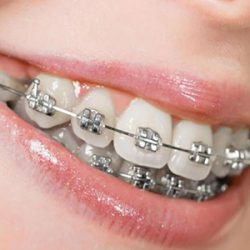
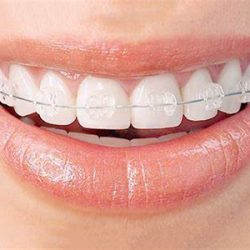
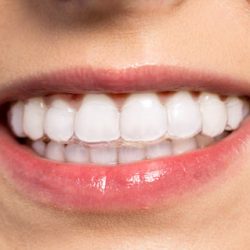
These braces are comprised of a series of clear, removable appliances known as clear aligners. They are much less visible than traditional braces. Since they are removable, there are no worries about them trapping plaque and food between the teeth.
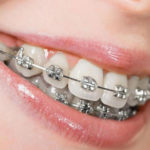
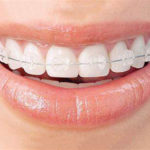
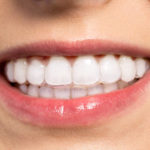
These braces are comprised of a series of clear, removable appliances known as clear aligners. They are much less visible than traditional braces. Since they are removable, there are no worries about them trapping plaque and food between the teeth.
There will be a small learning curve to eating with braces. Most people learn quick and it becomes second nature. Avoid sticky, gooey, crunchy items like toffees, ice, or jolly ranchers. It is always advisable to start with soft foods to go through an adjustment phase and then progressively incorporate regular foods on a daily basis.
Being careful with your new braces allows treatment to progress efficiently.
Please avoid these foods while wearing braces.
Braces and other modalities of orthodontics may be recommended by an orthodontist for the purpose of improving the orofacial appearance of a patient, enhancing growth and development of the jaws and enabling an aesthetic outcome. Problems such as crowded or crooked teeth, underbites or overbites, and incorrect jaw positions can be corrected with proper orthodontic treatment. Such problems, when left untreated, can result in gum disease, tooth decay, earaches and headaches, chewing or biting problems, and even difficulty speaking.
Orthodontics is a specialty practice of dentistry that focuses on the diagnosis and treatment of irregularities in the alignment and occlusion of the teeth and jaws.
An orthodontist is a specialist who has received at least two years of additional training to monitor growth,development and orthopedic changes, correct the alignment of teeth, improve the function of smiles, as well as correct the misalignment of jaws through surgical treatment.
Among the advantages of orthodontics include:
The reasons for seeking orthodontic treatment could include:
Below are some of the more common signs that might indicate the need for orthodontic treatment:
You should always brush your teeth after every meal. Additionally, it’s important to floss at least once a day. Use a fluoride toothpaste. Be sure to ask our office if you should use a fluoride rinse, as well. Doing so can help to prevent cavities.
If you use a retainer, it’s important to keep it safe in the correct container when you are not wearing it to keep it from getting broken or lost. The best way to keep your retainer clean is to brush it gently using a toothbrush and regular toothpaste. You should never place your retainer in the dishwasher or boiling water.
It’s important to avoid foods with a higher sugar content. Consuming sugary foods can make it easier for bacteria to buildup in your mouth, which can lead to the development of plaque and potentially cavities.
You should also avoid chewy and sticky foods, such as caramel and gum, as well as hard foods, like ice and hard candies. These types of foods can easily become stuck in your braces.
Always make sure you schedule regular appointments with our office.
While it would be hoped that you never experience a true orthodontic emergency, if you do, our team is always ready to assist. Should you have a painful problem with an orthodontic appliance or experience pain that you are not able to alleviate on your own, please contact our office. We will be happy to schedule an appointment.
In some instances, you may be able to resolve the problem on your own temporarily until you can come into our office. Keep in mind that if you are able to resolve the discomfort on your own, it is still crucial that you contact our office as quickly as possible to schedule an appointment to evaluate the concern. Furthermore, if you allow an orthodontic appliance to remain damaged for a long period of time, your treatment plan could be disrupted.
It is common to experience some soreness in your mouth after you initially have your braces fitted. You should expect your teeth to feel somewhat tender for up to five days. During this time, it’s best to restrict your diet to soft foods that will not hurt your teeth while chewing. If you experience any sore spots or irritated gums, try rinsing your mouth using a warm salt-water mouthwash. If the soreness is severe, or you have a hard time adapting, a minor pain killer can help alleviate these symptoms.
You may also notice that your cheeks, lips, and tongue experience some irritation for up to two weeks after being fitted with your braces. This is because your mouth is learning a new posture. Wax can help to alleviate this discomfort. We will be happy to show you how to apply wax on your braces.
Relief wax can help to alleviate some of the discomfort you may feel while wearing braces by providing a buffer between your lip or cheek and your braces. To use the wax, pinch off a small piece and then roll it into a small ball. Next, flatten the ball of wax and position it over the area of your braces or appliance that is causing the discomfort. If you continue to experience discomfort, please do not hesitate to contact our office. An adjustment may be necessary. Do not be concerned if you accidentally swallow a piece of wax. It is completely harmless.
Brackets serve as the handles to hold the wires in your braces in place. An adhesive is usually used to bond the brackets to your teeth. Generally, brackets are sturdy, stable, and tough. Even so, eating crunchy, sticky, or hard foods can loosen the brackets. Brackets can also become loose if you take a blow to the mouth. Wearing a mouth guard during any form of physical activity can help to reduce the chance of your brackets becoming loose.
If you experience a problem with a loose bracket and it can be removed easily, it should be placed in an enveloped and brought with you to your next appointment at our office. If the band or bracket is still attached, try to keep it in place. Wax can be used to alleviate any discomfort you may experience.
Although braces are quite stable and sturdy, they do need to be treated with care. This requires eating foods that are easy on the wires and brackets that form your braces. As a general rule, you should avoid any foods that are chewy, hard, or sticky. Soft foods will be easier on your braces. Below is a list of foods that should be avoided while wearing braces:
The following foods do not need to be avoided, but you should not bite into them using your front teeth. Instead, break them up or cut them prior to eating:
“Overall, braces and orthodontics devices today tend to be much less visible and comfortable than they once were. Any type of orthodontic treatment will still require a period of adjustment. Foods can become caught in wires and around brackets. Flossing and brushing can be more time-consuming. Patients may also experience slight soreness following an adjustment. Pain relievers, such as ibuprofen, can help to alleviate minor tooth discomfort. The introduction of more flexible, lighter wires has significantly reduced the amount of discomfort experienced during treatment.”

Welcome to mBrace Frisco Orthodontics! Dr. Shireen & her team are one of the highest rated practices in the Dallas / Fort Worth area.

©2022 by The Tactical Company

mBrace makes it easier than ever to get started with braces or Invisalign. Fill out the form and we’ll send you info on our easy payment plans!